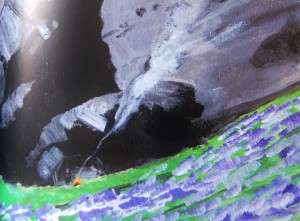The Truth is a Cave in the Black Mountains
Neil Gaiman
Illustrated by Eddie Campbell
William Morrow
Release Date: June 17, 2014
ISBN 978-0-06-228214-9
Back in 2010, Neil Gaiman was asked to read one of his stories at the Sydney Opera House during the GRAPHIC festival (“celebrating the art of graphic storytelling, animation and music”), and he chose an unpublished story about two men travelling the Highlands of Scotland on what begins as a quest for riches and turns into a story about revenge. He recruited artist Eddie Campbell, a long time friend, to paint pictures which were then projected behind Mr. Gaiman as he read, accompanied by music from the FourPlay String Quartet. The night was a huge success, and was recreated later at another festival in Hobart, Tasmania. The tale, titled “The Truth is a Cave in the Black Mountains”, was published 2011’s anthology Stories (edited by Mr. Gaiman and Al Sarrantonio).
 Now the story is back as a standalone book designed by Mr. Campbell using his original paintings and adding more artwork – including comics – to the illustrations that accompany the words (and sometimes, that embody the words). It is “not pure prose, not a graphic novel,” according to Mr. Gaiman’s afterword, “It’s a story with pictures unlike anything else I’ve written.”
Now the story is back as a standalone book designed by Mr. Campbell using his original paintings and adding more artwork – including comics – to the illustrations that accompany the words (and sometimes, that embody the words). It is “not pure prose, not a graphic novel,” according to Mr. Gaiman’s afterword, “It’s a story with pictures unlike anything else I’ve written.”
And it’s marvelous.
The story follows the tale of an unnamed narrator, a dwarf, who recruits a border reaver (raider) by the name of Calum MacInnes to guide him to a mythical cave on the Misty Isle. The reaver has been to the cave before, a cave filled with cursed gold. The legend is that every time one enters the cave and takes its gold, they lose some goodness from their soul. MacInnes, who had entered the cave once, vows never to enter it again but does agree to take the dwarf there – for a price.
The story follows the two men’s journey to the Misty Isle, including a litany of those they  encounter along the way. The assumption is that the dwarf wishes to obtain the gold in the order to assist “the king across the water” (James II & VII) in resuming his place on the Scottish throne, but the outcome of their journey turns out to have a far, far different ending. It truly becomes “a tale of travel and darkness”.
encounter along the way. The assumption is that the dwarf wishes to obtain the gold in the order to assist “the king across the water” (James II & VII) in resuming his place on the Scottish throne, but the outcome of their journey turns out to have a far, far different ending. It truly becomes “a tale of travel and darkness”.
Based on a line from a book on the legends of the Scottish Inner and Outer Hebrides written by the late Otta F. Swire, Mr. Gaimen tells this tale as only he can: simply, yet with a moody intensity full of half exposed truths and veiled premonitions. The tale is far more complex than it reads, but flows so effortlessly that you don’t realize how many components have been woven into its fabric.
I thought about it. “Sometimes I think that truth is a place. In my mind, it is like a city: there can be a hundred roads, a thousand paths, that will all take you, eventually, to the same place. It does not matter where you come from. If you walk towards the truth, you will reach it, whatever path you take.
Calum MacInnes looked down at me and said nothing. Then, “You are wrong. The truth is a cave in the black mountains. There is one way there, and one way only, and that way is treacherous and hard. And if you choose the wrong path you will die alone, on the mountainside.”
The accompanying full color illustrations by Mr. Campbell are perfectly suited to the haunting story line. They are severe and strong, vivid yet dark; the dialog written in the comic panels is elemental and raw. The brushstrokes evidence a thick, heavy texture, the washes are suggestive behind black inks. They seem to show little, yet express so very much.
In this day of glib and polish, something as gruff and elemental and, well, real as The Truth is a Cave in the Black Mountains is welcome and indeed, rewarding. It’s like Scotland: brooding, harsh, and utterly gorgeous.

